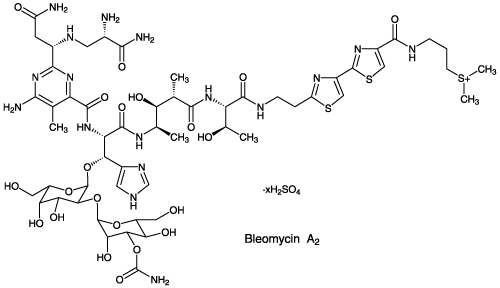Replaces Prod. #: ALX-630-107
- Antibiotic with anti-cancer and apoptotic properties
- Radiomimetic DNA-cleaving agent that produces double and single DNA strand breaks through an oxygen-radical-dependent mechanism
- Highly cited
Bleomycin consists in a complex of 11 glycopeptide anti-cancer antibiotics originally isolated from Streptomyces verticillus. The dominant components of the complex are bleomycin A2 and B2, which typically represent >90% of the total weight. Bleomycin has found clinical application in the treatment of a range of tumors. Bleomycin acts by intercalation of DNA and RNA. In the presence of oxygen and metal ions (e.g. copper and iron), Bleomycin forms a pseudo-enzyme that induces DNA cleavage.
Product Details
| Alternative Name: | Blenoxane |
| |
| Formula: | C55H85N17O25S4 |
| |
| MW: | 1512.6 |
| |
| Source: | Isolated from Streptomyces sp. |
| |
| CAS: | 9041-93-4 |
| |
| MI: | 14: 1318 |
| |
| RTECS: | EC5991990 |
| |
| Purity: | ≥98% (HPLC) |
| |
| Appearance: | White crystalline solid. |
| |
| Solubility: | Soluble in 100% methanol or water (20mg/ml). |
| |
| Shipping: | Ambient Temperature |
| |
| Long Term Storage: | -20°C |
| |
| Use/Stability: | Stable for at least 1 year after receipt when stored, as supplied, at -20°C. Stock solutions are stable for up to 3 months at -20°C. |
| |
| Regulatory Status: | RUO - Research Use Only |
| |
Please mouse over
Product Literature References
A Proximity Ligation Method to Detect Proteins Bound to Single-Stranded DNA after DNA End Resection at DNA Double-Strand Breaks: F.C. Fowler & J.K. Tyler; Methods Protoc.
5, 3 (2022),
Abstract;
Ameliorating Fibrosis in Murine and Human Tissues with END55, an Endostatin-Derived Fusion Protein Made in Plants: L. Mlakar, et al.; Biomedicines
10, 2861 (2022),
Abstract;
Skin fibrosis and recovery is dependent on Wnt activation via DPP4: A. Jussila, et al.; J. Invest. Dermatol.
142, 1597 (2022),
Abstract;
A model of the aged lung epithelium in idiopathic pulmonary fibrosis: H. Shaghaghi, et al.; Aging
13, 16922 (2021),
Abstract;
Full Text
Discovery of the S1P2 antagonist GLPG2938 (1-[2-Ethoxy-6-(trifluoromethyl)-4-pyridyl]-3-[[5-methyl-6-[1-methyl-3-(trifluoromethyl)pyrazol-4-yl]pyridazin-3-yl]methyl]urea), a preclinical candidate for the treatment of idiopathic pulmonary fibrosis: O. Mammoliti, et al.; J. Med. Chem.
64, 6037 (2021),
Abstract;
Electrochemotherapy in 3D ocular melanoma spheroids using a customized electrode: M. Fiorentzis, et al.; J. Vis. Exp.
158, e60611 (2020),
Abstract;
Inflammatory drivers of cardiovascular disease: molecular characterization of senescent coronary vascular smooth muscle cells: S. Stojanovic, et al.; Front. Physiol.
11, 520 (2020),
Abstract;
Full Text
Thymic stromal lymphopoietin protects in a model of airway damage and inflammation via regulation of caspase-1 activity and apoptosis inhibition: N. Shubin, et al.; Mucosal Immunol.
13, 584 (2020),
Abstract;
Full Text
Direct intrabronchial administration to improve the selective agent deposition within the mouse lung: S. Liao, et al.; J. Vis. Exp.
147, e59450 (2019),
Abstract;
MERIT40-dependent recruitment of tankyrase to damaged DNA and its implication for cell sensitivity to DNA-damaging anticancer drugs: O. Keiji et al.; Oncotarget
9, 25844 (2018),
Abstract;
Full Text
ASF1a Promotes Non-homologous End Joining Repair by Facilitating Phosphorylation of MDC1 by ATM at Double-Strand Breaks.: K.Y Lee et al.; Mol. Cell
5, 51 (2017),
Abstract;
Full Text
Overexpression screens identify conserved dosage chromosome instability genes in yeast and human cancer: S. Duffy, et al.; PNAS
113, 9967 (2016),
Application(s): Sensitivity to Genotoxic Agents, Yeast strains carrying each dCIN candidate
,
Abstract;
Full Text
Extracellular ATP mediates the late phase of neutrophil recruitment to the lung in murine models of acute lung injury: D. Shah, et al.; Am. J. Physiol. Lung Cell. Mol. Physiol.
306, L152 (2014),
Abstract;
Full Text
Targeting Her-2+ breast cancer cells with bleomycin immunoliposomes linked to LLO: M. Kullberg, et al.; Mol. Pharm.
9, 2000 (2012),
Abstract;
Bleomycin-induced alterations in DNA replication: relationship to DNA damage: J. Dziegielewski, et al.; Biochemistry
40, 704 (2001),
Abstract;
Bleomycin: new perspectives on the mechanism of action: S.M. Hecht; J. Nat. Prod.
63, 158 (2000),
Abstract;
Synergistic effects of laserthermia and bleomycinsulfate on micronuclei formation in cytokinesis-blocked HeLa cells: A.S. Monfared & H. Mozdarani; Irn. J. Med. Sci. 24, 87 (1999),
Antiangiogenic chemotherapeutic agents: characterization in comparison to their tumor growth inhibition in human renal cell carcinoma models: M. Schirner, et al.; Clin. Cancer Res.
4, 1331 (1998),
Abstract;
Changes in c-Jun but not Bcl-2 family proteins in p53-dependent apoptosis of mouse cerebellar granule neurons induced by DNA damaging agent bleomycin: T. Araki, et al.; Brain Res.
794, 239 (1998),
Abstract;
Induction of apoptosis by bleomycin in resting and cycling human lymphocytes: P. Vernole, et al.; Mutagenesis
13, 209 (1998),
Abstract;
p53 activates the CD95 (APO-1/Fas) gene in response to DNA damage by anticancer drugs: M. Muller, et al.; J. Exp. Med.
188, 2033 (1998),
Abstract;
Regulation of apoptosis in mouse hepatocytes and alteration of apoptosis by nongenotoxic carcinogens: J.G. Christensen, et al.; Cell Growth Differ.
9, 815 (1998),
Abstract;
Sequence-specific changes in the metal site of ferric bleomycin induced by the binding of DNA: J.W. Sam, et al.; J. Biol. Chem.
273, 16090 (1998),
Abstract;
Cleavage of tRNA by Fe(II)-bleomycin: A. Huttenhofer, et al.; J. Biol. Chem.
267, 24471 (1992),
Abstract;
Chromatin structure during bleomycin-induced DNA damage and repair: B.P. Cuiffo, et al.; J. Free Radic. Biol. Med.
1, 139 (1985),
Abstract;
Specificity of deoxyribonucleic acid cleavage by bleomycin, phleomycin, and tallysomycin: J. Kross, et al.; Biochemistry
21, 4310 (1982),
Abstract;
Bleomycin and other antitumor antibiotics of high molecular weight: H. Umezawa; Antimicrob. Agents Chemother. (Bethesda)
5, 1079 (1965),
Abstract;
Related Products










